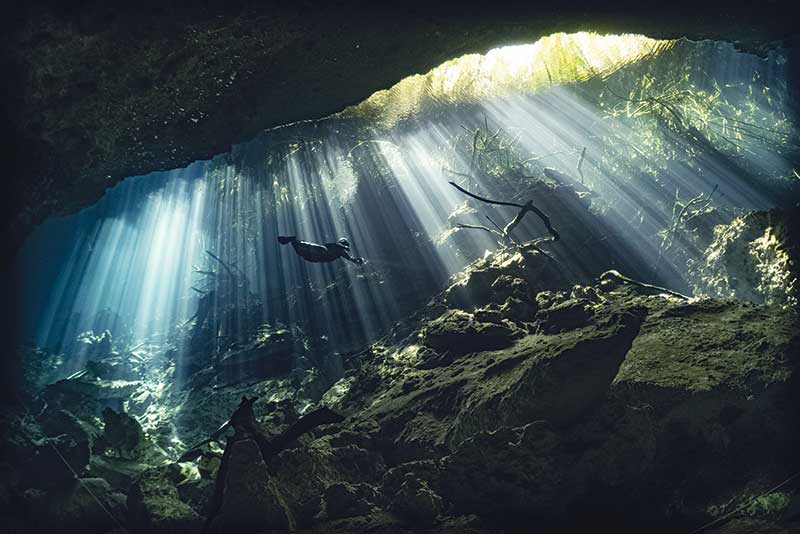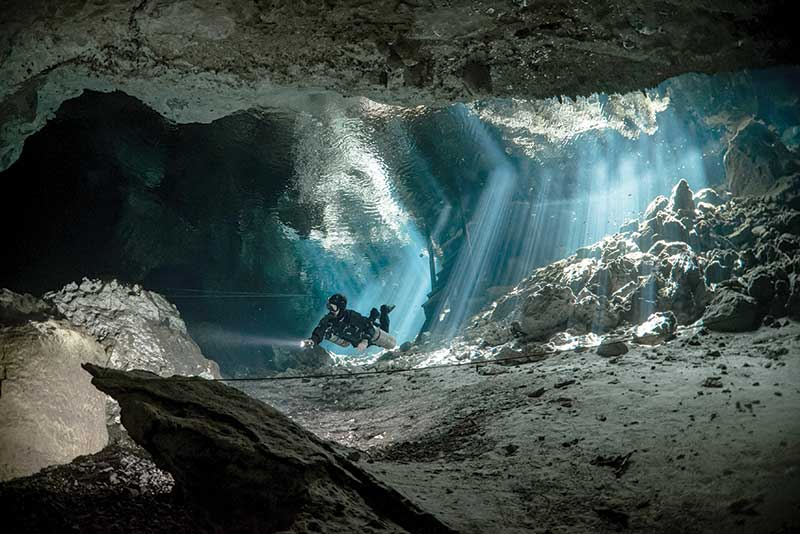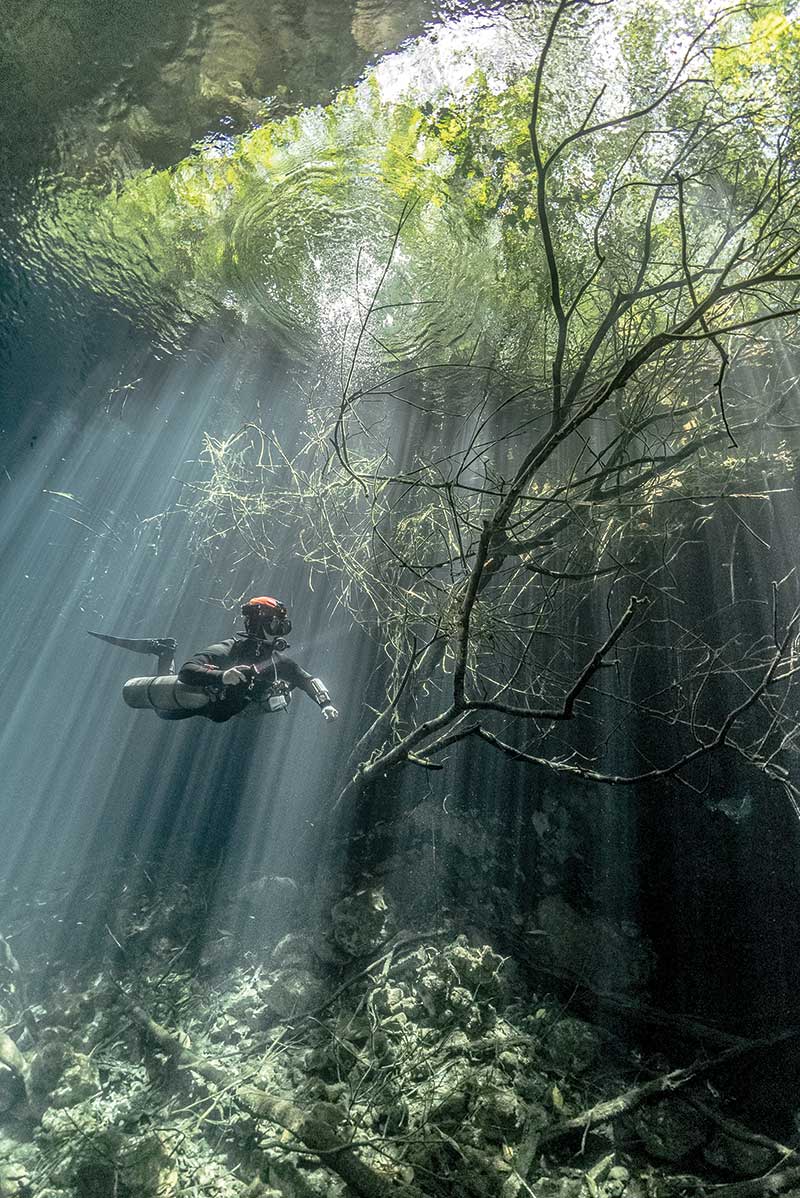The age of enlightenment – Diving cenotes and caves in Mexico
Exciting and astonishingly beautiful, the cenotes and caves of Mexico’s Yucatan Peninsula have carved out a booming industry, and offer a truly unique perspective for divers
Words and Photos by Natalie Gibb

Flooded caves. For the uninitiated, they are the stuff of nightmares, conjuring visions of terrifying black tunnels and claustrophobic spaces. Yet divers who have visited the Mexican cenotes speak of their experiences with different adjectives – describing otherworldly beauty, unimaginably large chambers, and astonishing light beams dancing through the water column. There’s a disconnect between the media-hyped danger of venturing into the overhead and the reality of the relatively safe, modern practices of cave diving. You don’t need to be a testosterone-fueled adrenaline junky to enjoy the overhead environment. In fact, it’s better if you’re not! Here’s your primer on all things cave – from how you can enjoy the cenotes safely as a recreational diver, to how you can take your diving to the next level and become a certified cave diver.
The term cenote is derived from the Mayan word dz’not, and describes a sinkhole entrance to the subterranean cave system in Mexico’s Yucatan Peninsula. As the Yucatan Peninsula sits at a very low elevation, the water table near the coast is only a few metres below ground and most of the coastal caves are fully flooded. Cenotes are filled with shockingly clear water and resemble jungle oases: cool pools of water tucked into the hot, dense Yucatan jungle. They are popular with swimmers, snorkellers, and, of course, divers.
What’s there to see?
Unlike ocean diving, the freshwater cenotes are not full of wildlife. If ocean diving is like a safari, with divers looking for interesting creatures, cenote diving is similar to visiting a mountain or landscape with interesting scenery. Divers enjoy the topographical and geological features, and stunning vistas looking out on the jungle and sky.
Not all overhead diving takes divers into tight, small tunnels. One of the most astonishing aspects of the Mexican caves is the vast size of the underground spaces. Some caves have chambers larger than ballrooms, with massive, subway-sized tunnels snaking out in all directions. It’s fascinating to realize that there are similarly sized passageways spreading across the entire peninsula, just below your feet.

Many of the caves in the Yucatan were above the water table during the last glacial period, when sea levels were lower. This allowed the formation of speleothems – cave formations such as stalactites and stalagmites – which can only form in air-filled chambers under specific conditions. 10,000-12,000 years ago, at the end of the last glacial period, the sea level rose and flooded the caves, halting the growth of speleothems. Venturing into these tunnels feels like travelling back in time, viewing the caves as they were in the distant past.
Speleothems are as varied as the caves themselves. Some rooms are filled with massive, tree-like columns, metres in diameter. Other areas are decorated with thousands of tiny, thin stalactites called soda straws. These are often transparent, and sparkle and glow in a diver’s light beam. There are walls covered with ribbon-like flow stone, which looks like curtains or draperies of delicate fabric.
Near the entrances to the caves, sparkling light beams cut through the water. Filtering through the foliage above, they glimmer in vibrant hues of blue and green, and paint prisms of colour on the chamber floors. Gazing up into these rays of light feels like standing backstage at a concert, at a fantastic light show just for you.
Finally, there is the halocline. The term derives from the Greek halo, meaning salt, and cline, meaning gradient. The halocline is the interface, or mixing layer, of fresh and salt water. Rain water seeps into the cenotes from above ground, and salt water moves inward from the ocean. Where they meet, they form a distinct boundary, similar to olive oil and vinegar. This creates a blurry visual effect similar to a thermocline but much more pronounced. Floating above the halocline looks like swimming above an underwater river, ripples and all.

Have I piqued your curiosity?
For experienced divers, I feel cenote diving is a bucket-list experience that every diver should try at least once. It’s so unique! You do not need to be a certified cave diver to dive in these enchanting places. You should, however, be an experienced diver.
Cenote diving has become a bit of an industry in Mexico, and there’s at least a hundred dive shops that will happily take any diver, experienced or otherwise, into the cenotes. Contrary to this trend, I feel that diving in the overhead is an advanced diving environment and I limit the activity at my shop to experienced divers with solid dive skills. Divers entering the cenotes should have excellent buoyancy control; if you can hold a 15 ft (5m) safety stop horizontally with little depth deviation or fin movement, you are probably okay. Similarly, divers should be able to frog kick, and have solid horizontal trim.
Part of these requirements is for diver safety and conservation: divers who flutter kick in a head-up position will likely stir up sediment and disturb the visibility. Divers who have not mastered fine buoyancy control may impact the floor and formations. But it’s also important to realize that divers who do not yet find these skills innate will spend the majority of their time focused on the minutiae of diving and will not be able to turn their attention to the environment and enjoy a cohesive, relaxing experience. It’s not going to be fun if you are focused on your buoyancy the entire time.
When done properly, with a private guide, a guided cenote dive can be one of the most fantastic experiences of a diver’s career, and cenote diving is very safe! There’s a list of rules and safety guidelines that divers and guides follow to ensure that cenote diving is a controlled and low-risk activity.

What are the safety rules?
The first rule of guided cenote diving is that divers should always be able to see daylight. Light effects are one of the most beautiful aspects of cenote diving, so this fulfills two purposes. First: you have an absolutely beautiful dive! Second: you are always near a breathable surface. Where there is daylight, there is air; and in an emergency, cenote divers can ascend to any of the nearby surfaces. Daylight also provides a sense of reference for divers as they move through the cenote.
The second rule involves penetration distance. Divers on a guided cenote dive cannot swim further than 200 ft (60m) into the overhead. As the vast majority of cenote dives have an average depth of around 30 ft (10m). In an emergency, divers can get to a safe, breathable surface in just a few minutes. Compare this to a deep dive in the open water, where it is essential to maintain a safe ascent rate and conduct a required safety stop and it’s clear that timewise, a diver is actually closer to a safe, breathable surface during a shallow cenote dive than on a deep dive in the open water!
What about tight claustrophobic spaces? While it’s true that certified cave divers sometimes swim into small tunnels, one of the rules of guided cenote diving is that divers must remain in large space where two divers can pass easily side-by-side. This is both a conservation and safety rule. A diver is much less likely to impact the environment if there is ample space, and it’s important that divers have easy, quick access to a buddy’s alternate air source in an emergency – which they wouldn’t have if they were forced into single file. Of course, staying in big places is also more fun – guided cenote divers should be relaxing, not small, scary, and claustrophobic!
Getting lost? Not a concern! In addition to the requirement that there is visible light to guide divers to a surface, cenote divers also are required to stay within arm’s length of a guideline. The guideline serves as a pathway, leading divers into and out of the cavern safely. It can also become a physical reference if visibility is lost (although I know of no situation in which cenote divers lost visibility during a guided tour).
Finally, in the overhead environment, divers follow a strict gas management rule known as the ‘rule of thirds’. Divers may use only one third of their breathing gas for penetration, and then must turn around and exit. This means that at any point on the dive, a diver has a minimum of twice the gas required to exit. Add to this the fact that guides are required to use double tanks, and the team has a vast excess of gas to deal with any situation. Of course, there is always a surface nearby, and the divers do not need to swim the entire line to surface and breathe in an emergency.
There’s many more rules and guidelines to ensure diver safety, but these general protocols will hopefully convince you that cenote diving is reasonably safe and regulated with a reputable dive center.

How do I become a cave diver?
You totally should! Cave diving is the best thing in the world (according to me) and it will push you to improve your dive skills, and venture into some of the most unique parts of the planet. That said, becoming a cave diver is a journey. Most serious instructors break down the process into steps and encourage divers to gain experience and confidence at each level before continuing on to the next.
Aspiring cave divers must first train and gain experience in double tanks. In modern cave diving, divers can choose between back mount and sidemount. Backmount is by far simpler to learn, and but most divers feel that sidemount is more comfortable and versatile (plus you avoid lugging heavy doubles to the water). No matter which configuration a diver chooses, it’s not set in stone. It’s always possible to cross over to the other configuration.
For most training organizations, the next step is cavern diver training. This course teaches divers all the base level skills required in the overhead environment – such as running a reel, navigating, and following a guideline. During cavern diver training, divers also learn emergency management skills such as zero-visibility line following, exiting while sharing gas, and even exiting in zero visibility while sharing gas!
The next step is Intro to Cave (the course name may vary with organization). Intro to Cave is the first course where divers venture out of the daylight zone, to put their overhead skills to use in a real cave. There’s new skills in this course, such as finding a lost line in zero visibility and conducting a search for a lost buddy. Divers also practice emergency skills from cavern training in the cave. At this level, divers are limited to penetration of one sixth of their double tanks, are restricted to following a single guideline in and out of the cave with no intersections, and must stay in large open places that do not force divers into single file.
The final step is the Full Cave Diver certification. This certification trains divers to navigate down side tunnels, enter restrictions (tight places), and dive to a full one third of their breathing gas (although we always turn a little early).
Cave training is a commitment in time, energy, and money. It’s a pretty big deal! I generally encourage divers to go on a guided cenote dive and see what they think of the environment before making the commitment. With my shop the full process, including doubles training, takes a minimum of two weeks. Most divers spread out the courses over a period of trips and gain experience diving independently with a buddy (without a guide) after completing each level. Nothing makes me prouder as a cave instructor, than when my newly certified cave divers take off on their own.
Sounds intriguing, But is cave diving really dangerous?
Cave diving has a reputation as the world’s most dangerous sport. That was certainly true in the early days of cave diving, when intrepid adventurers were figuring out how to cave dive and how to stay safe. These days, cave diving enjoys a good safety record, and for divers who follow the modern cave diving procedures, I would argue that the sport is reasonably safe. It’s certainly safer than wing suiting or base jumping! I am more concerned about my safety while driving on a busy highway, where I have no control over the actions of others, than I am when diving in a flooded cave!
Most cave diving accidents are caused by diver error. I know of only two accidents in modern cave diving that were beyond the diver’s control, and both of those were in exploration scenarios, where the diver was pushing the limits of the sport.
What behaviours should cave divers avoid to remain safe?
There’s five main causes of accidents in cave diving, known in cave diving circles as the Rules of Accident Analysis (see above). Don’t do these things, and you will be fine.
Keep in mind that violating any of these rules is a choice a cave diver makes. It’s easy to choose to be safe! Don’t like tight caves? You never need to go into a tight cave. Silt outs? Don’t go into silty caves. Cave collapse? It’s pretty easy to notice if the cave ceiling is crumbling on you. Stay on established cave lines and don’t swim into unstable places. It’s important to realize that you can always turn around, and that you never have to do anything you don’t want to. As long as a cave diver makes safe choices and is comfortable putting the ego aside and ending a dive if he is uncomfortable, there’s no reason modern cave diving has to be dangerous!
Flooded caves are one of the most spectacular, exciting places a diver can visit. The cenotes in Mexico are my favourite type of cave, and you don’t need to be a certified cave diver to visit them. It’s an environment every serious diver should consider checking out once in his or her diving career. Who knows, you might end up becoming a cave diver yourself one day.

Rules of Accident Analysis:
Rule #1: Seek proper training. Divers who enter a cave without cave training are one of the highest fatality demographics. They simply don’t know what they don’t know, and break safety rules that a trained cave diver would not consider violating. Simply completing a proper cave diving course and following the procedures outlined in that course avoids most accidents.
Rule #2: Depth is dangerous. Deep diving in caves is certainly risker than shallow cave diving. Depths requiring trimix, decompression, or other advanced diving techniques add to the diver’s risk. With modern dive gear, the use of trimix to avoid narcosis and other issues associated with depth, and the quality of decompression training, depth is less of a concern than it used to be. However, there’s no reason a cave diver ever needs to dive deeper than 40 ft (12m)! Mexico is filled with a lifetime’s worth of shallow cave dives.
Rule #3: Don’t break the gas management rule of thirds. Clearly, running out of breathing gas is a major concern. By always reserving at least two-thirds of your breathing gas for your exit, you can exit on only one tank if you have a gear failure or gas loss or donate gas to a buddy and get both team members out safely. The extra third of gas gives you ample time to deal with problems. Divers are often even more conservative with their gas management on difficult dives, as they should be.
Rule #4: Make sure you have adequate redundancy of all vital gear. Make sure it’s working before the dive. Safe cave divers carry double of everything – two tanks, two regulators, two back up lights, etc. This ensures that a single gear issue will never endanger a diver’s life. Additionally, a diver’s buddies have redundant gear, to donate to the diver in an emergency. Of course, the gear is only helpful if it works, so check all your gear, in the water, immediately before descending.
Rule #5: Always have a properly marked, continuous guideline to the open water. A diver who ensures that he stays near the cave line and marks his exit at any intersections with a cave marker has no reason to get lost, not even if he loses visibility. As long as you stay near the guideline and mark it properly, you will always be able to find your exit.
For more information visit: www.underthejungle.com
Leave a Comment







